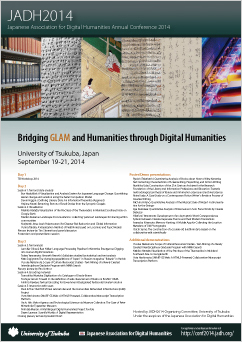Poster session 3
A Case Study of a Contemporary Fiction Writer's Revision Process for Creative Writing
- Akira Kudo (University of Tokyo)
- Takeshi Okada (University of Tokyo)
- Dominick Chen (Dividual Inc.)
To date, there has been little attention to the creative processes of expert writers, such as fiction writers, poets, and script writers, because creative writing has generally been seen as shaped by practice and education. In general, previous studies of writing have used the methodology of creative experiments and protocol analysis, although there have been few studies of the authentic writing situation due to difficulties with the approach. Moreover, there have been insufficient investigations into the characteristics of writing and revision using word processors that are generally ubiquitous. Although traditional literary research have tracked handwritten additions and deletions to manuscripts for insights into the creative writing process, as Yoshida (2007) points out, with contemporary writers using word processors, prior versions of a manuscript are generally not available.
The purpose of this case study is to describe the revision processes of a contemporary expert fiction writer from a cognitive science perspective. More specifically, we utilize Type Trace which is a text editor devised by Dividual Inc. as an analysis tool for observing the writing process(Chen, 2013). Type Trace makes it possible to record and reproduce the processes involved in the usual inputting of text and preparing drafts. This study focuses on a Type Trace record for “Maijo Novel Powder Snowstorm” (2007), written by Otaro Maijo, who has been a writer of fiction covering many genres since 2001. In particular recognition of his achievement in literature, he was awarded the Mishima Prize for “Ashura Girl” (2003). More importantly, it's also unusual that Maijo is an anonymous author who has not revealed a private information before, therefore it can be saying that selecting Maijo as a target is extremely significant in ‘research for fiction writer’.
First, revisions are categorized as either additions, deletions, substitutions, permutations, distributions, or consolidations based on observations of Maijo's writing process (cf. Faigley & Witte, 1981). Second, revisions are further defined “generative revisions”, where a new text is produced, or as “retroactive revisions”, where the text is corrected or modified by substitution or addition. Comparisons of these revisions indicated that generative revisions were three times more frequent than retroactive revisions, suggesting that many revisions simultaneously involved the generation of new text. Substitutions and additions constituted 80 and 10 percent, respectively, of the generative revisions. In contrast, substitutions and additions comprised 30 and 60 percent, respectively, of the retroactive revisions. These results indicate that writing during periods of generation proceeds with minor substitution-based adjustments, while writing during revision periods proceeds by enriching the rhetoric and expressions through additions. The distributions that separate a sentence into two sentences and the consolidations that combine two sentences into a sentence have a high ratio of generative revisions to retroactive revisions, indicating that the rhythm from sentence length is mostly determined at the text production stage.
- Keywords
- creativity, literature, creative writing, revision process
Reference
- Chen, D.: Internet wo seimeika suru prochronism no siso to jissen [Vitalizing the Internet: Theory and Practice of Prochronism], Tokyo: Seidosha Inc. (2013).
- Faigley, L. and Witte, S.: Analyzing Revision. College Composition and Communication, pp. 400–414 (1981).
- Maijo, O.: Ashura girl [Ashura girl], Tokyo: Shinchosha Co., Ltd. (2003).
- Maijo, O.: Maijo shosetsu kona fubuki [Maijo Novel Powder Snowstorm], Gunzo, Vol. 63, No. 1, pp. 36–57, Tokyo: Kodansha Co., Ltd. (2007).
- Yoshida, J.: Shosetsu no shinso wo meguru tabi: Proust to Ryunosuke Akutagawa [The travel over deep layer of novel: Proust and Akutagawa], Tokyo: Iwanami Publishing Co., Ltd. (2007).

